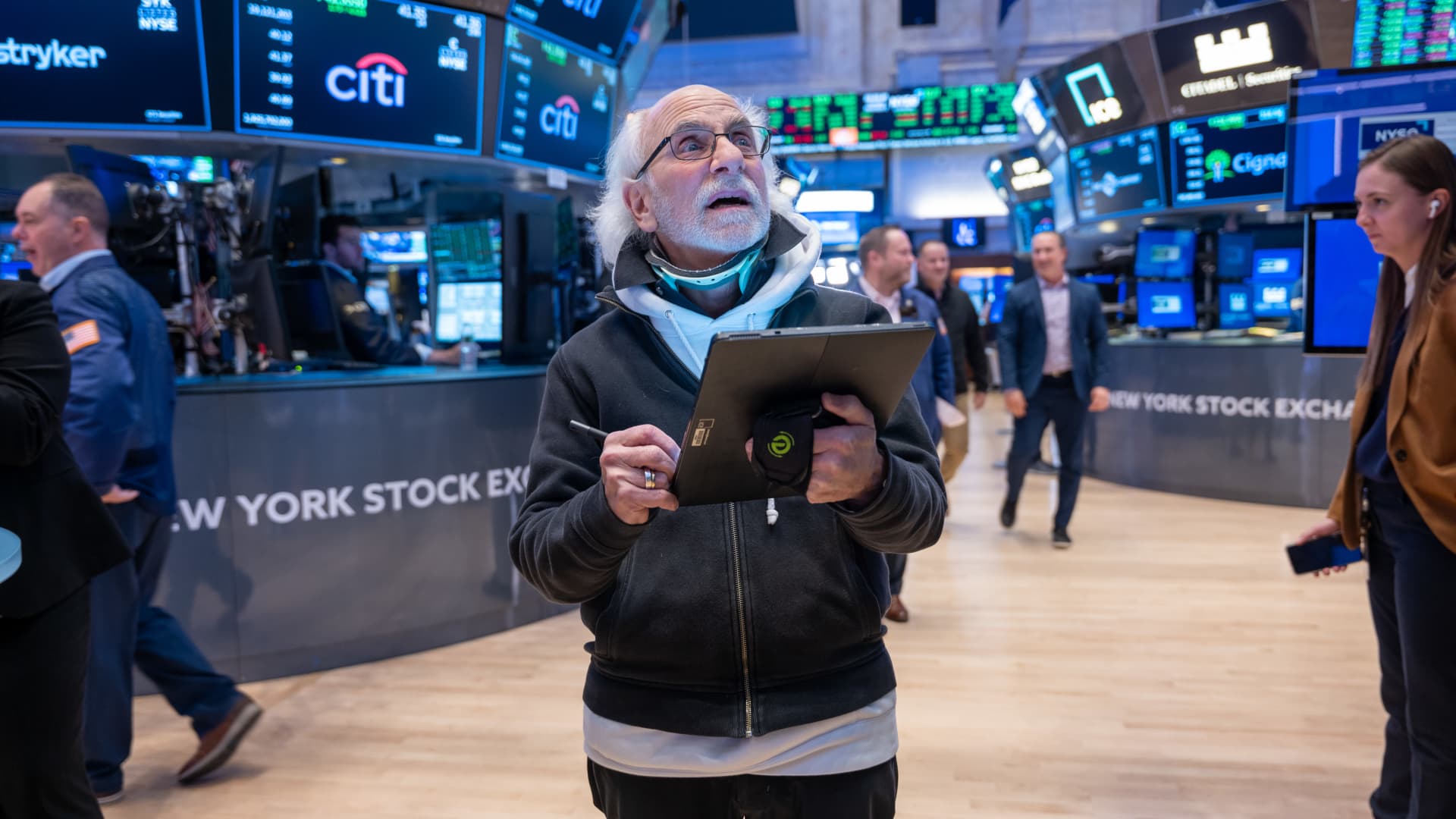Economy
Bad news for the economy is good news for the stock market … as long as it doesn’t get too bad

Friday’s market reaction to the jobs report comes down to a simple premise: bad news is good news, as long as it isn’t too bad.
Stocks rallied sharply after the Labor Department said nonfarm payrolls rose by 150,000 in October — 20,000 fewer than expected but a difference attributable pretty much completely to the auto strikes, which appear to be over.
For the Federal Reserve, the relatively muted job creation coupled with wage gains nearly in line with expectations adds up to a scenario in which the central bank doesn’t really have to do anything. It can just continue to let the data flow in, without having to move on interest rates as it evaluates the impact of its previous 11 hikes.
“The Fed finally got what it’s been looking for — a meaningful slowdown in the labor market,” said Mike Loewengart, head of model portfolio construction for Morgan Stanley’s Global Investment Office.
“We’ve seen one or two head fakes in this direction before, but the fact that this report followed other weaker-than-expected economic data points this week may encourage investors who have been waiting for a less-hawkish Fed,” he added.
Markets reacted in more ways than one to the report. Traders in fed funds futures reduced the probability for a December rate hike to less than 10% and now see the first cut coming as soon as May, according to CME Group tracking.
However, that cut could be the really bad news, as it likely would signal the Fed’s concern that the economy is slowing so much that it needs a boost from monetary policy. Slow, controlled growth is something the markets and the Fed are seeking in the current climate, negative growth is not.
“Investors who are eager for the Fed to be cutting rates should be careful what they wish for,” Michael Arone, chief investment strategist at State Street Global Advisors, said in an interview earlier this week.
Despite market pricing, it seems like cuts aren’t around the corner if recent statements from Fed officials are any indication. Fed Chairman Jerome Powell said Wednesday that cuts have not been a part of the conversation among policymakers.
“It seems like that’s still a ways off in my mind,” Richmond Fed President Thomas Barkin said during an interview Friday on CNBC’s “Squawk on the Street.” “You could imagine scenarios where demand comes off and you have to do something. You could imagine a scenario where inflation is starting to settle and you want to lower real rates. Both of those imaginary things still feel pretty far out the distance.”

Economy
Norway’s Economy Ekes Out a Gain for Third Straight Quarter
(Bloomberg) — The Norwegian economy recorded a third consecutive quarter of expansion, as a recovery in purchasing power bolstered car purchases and a weak krone underpinned exports.
Mainland gross domestic product, which excludes offshore energy industry and shipping, grew by 0.1% in the second quarter from the previous three months, according to a release from Statistics Norway published Thursday. First-quarter growth was revised lower to 0.1%.
Thursday’s reading was just below the 0.2% growth estimated by both the central bank and economists in a Bloomberg survey.
The outcome shows the energy-rich Nordic nation is dented more than previously assumed by the fallout from interest rates at a 15-year high, even as the slowing inflation and wage growth above 5% fuel consumption.
The weaker-than-forecast figures, together with revision of earlier data, may still increase the odds of Norges Bank reducing borrowing costs before next year. The Norwegian policymakers have kept delaying monetary easing as one of the most aggressively hawkish in the rich world, forecasting no change “for some time ahead” at their meeting last week.
“Negative revisions clearly leave a picture of a weaker mainland economy than Norges Bank projected back in June,” said Kristoffer Kjaer Lomholt, head of FX and corporate research at Danske Bank A/S. “All in all, a report that should keep the door open for a December cut.”
Household consumption grew by 1.6% on quarter due to a “strong upswing” in car purchases, the statistics office said, while noting the figures for the sector can fluctuate “widely.” Trade and power supply also helped boost mainland growth, it said.
The krone is hovering near four-year lows, helping demand for Norwegian exports, as well as its tourism sector. It was little changed following the report, trading 0.1% lower at 11.7233 versus the euro at 8:50 a.m. in Oslo.
Total exports grew 5.6% on quarter, the fastest increase in almost two years, as oil and gas shipments were less affected by maintenance works that are usual for the season.
The country’s largest lender, DNB Bank ASA, on Wednesday kept its forecast for full-year growth of 0.8% in 2024 and projected next year’s growth at 1.6%, largely due to higher purchasing power of consumers. That compares with Norges Bank’s estimates of expansion of 0.8% and 1.3%, respectively, published in June.
Analysts at DNB and Svenska Handelsbanken AB said the deviation from the central bank’s estimates was too small to clearly affect policymakers’ rate outlook.
–With assistance from Joel Rinneby.
(Updates with analyst comment, market reaction from fourth paragraph.)
©2024 Bloomberg L.P.
Economy
Gaza war extends toll on Israel’s economy
Last week, Fitch Ratings downgraded Israel’s credit score from A+ to A. Fitch cited the continued war in Gaza and heightened geopolitical risks as key drivers. The agency also kept Israel’s outlook as “negative”, meaning a further downgrade is possible.
After Hamas’s deadly attack on October 7, Israel’s stock market and currency nosedived. Both have since bounced back. But concerns about the country’s economy persist. Earlier this year, Moody’s and S&P also cut their credit ratings for Israel.
So far, Israel’s war on Gaza has killed more than 40,000 Palestinians and decimated the economy in the besieged Palestinian enclave.
There are signs of a blowback in Israel, too, where consumption, trade and investment have all been curtailed.
Separately, Fitch warned that heightened tensions between Israel and Iran could incur “significant additional military spending” for Israel.
The Bank of Israel has estimated that war-related costs for 2023-2025 could amount to $55.6bn. These funds will likely be secured through a combination of higher borrowing and budget cuts.
The upshot is that combat operations are putting a strain on the economy. On Sunday, Israel’s Central Bureau of Statistics estimated that output grew by 2.5 percent (at an annual rate) in the first half of 2024, down from 4.5 percent in the same period last year.
Slowing growth
Before the outbreak of the war, Israel’s economy was forecast to grow by 3.5 percent last year. In the end, output expanded by just 2 percent. An even sharper drop was avoided thanks to the country’s all-important tech sector, which has been largely unaffected by fighting.
Other parts of the economy have taken a significant hit. In the final quarter of last year and in the weeks after the war began, Israel’s gross domestic product (GDP) shrank by 20.7 percent (in annual terms). The slump was driven by a 27 percent drop in private consumption, a drop in exports and a slash in investment by businesses. Household expenditure snapped back at the start of the year, but has since cooled.
Israel also imposed strict controls on the movement of Palestinian workers, forgoing up to 160,000 workers. To tackle those shortages, Israel has been running recruitment drives in India and Sri Lanka with mixed results. But labour markets remain undersupplied, particularly in the construction and agriculture sectors.
According to the business survey company CofaceBDI, roughly 60,000 Israeli companies will close this year due to manpower shortages, logistics disruptions and subdued business sentiment. Investment plans have, in turn, been delayed.
At the same time, tourist arrivals continue to fall short of pre-October levels.
Meanwhile, the war has triggered a steep rise in government spending. According to Elliot Garside, a Middle East analyst at Oxford Economics, there was a 93 percent increase in military expenditure in the last three months of 2023, compared to the same period in 2022.
“In 2024, monthly data suggests military expenditure will be around double the previous year,” Garside said. Much of that increase will be used on reservist wages, artillery, and interceptors for Israel’s Iron Dome defence system.
Garside told Al Jazeera these expenditures “have mostly been financed by issuance of domestic debt”.
Israel has also received some $14.5bn supplemental funding from the United States this year, on top of the $3bn in annual aid that the US provides to the country.
Garside noted, “We are yet to see any major cutbacks to other parts of the budget [like healthcare and education], although it is likely that cuts will be made in the aftermath of the conflict.”
Absent a full-scale regional war, Oxford Economics anticipates that Israel’s economy will slow to 1.5 percent growth this year. Subdued growth and elevated deficits will put further pressure on Israel’s debt profile, which will likely raise borrowing costs and soften investor confidence.
Bruised public finances
Fitch expects Israel to permanently increase military spending by 1.5 percent of GDP compared to prewar levels, with unavoidable consequences for the public deficit. Last week’s rating report noted that “debt [will] remain above 70 percent of GDP in the medium-term”.
What’s more, the rating agency warned that “the conflict in Gaza could last well into 2025 and there are risks of it broadening to other fronts”.
Regional conflict
On Monday, US Secretary of State Antony Blinken said that Netanyahu had accepted a “bridging proposal” designed to reach a ceasefire between Israel and Hamas and diffuse growing tensions with Iran.
The following day, eight Palestinians were killed in an Israeli attack on a crowded market in Deir el-Balah, in central Gaza.
Hamas has yet to agree to the bridging proposal, calling it an attempt by the US to buy time “for Israel to continue its genocide”. Instead, the Palestinian group has urged a return to a previous proposal announced by US President Joe Biden, which has more guarantees that a ceasefire would bring about a permanent end to the war.
Netanyahu has insisted that the war will continue until Hamas is totally destroyed, even if a deal is agreed. Israeli officials, including Defence Minister Yoav Gallant, have rubbished the idea of a total victory against Hamas.
A decades-old shadow war between Israel and Iran surfaced in April, when Tehran launched hundreds of drones and missiles at Israel in response to the killing of two commanders from Iran’s Islamic Revolutionary Guard Corps (IRGC) in Damascus.
Along its Lebanese border, Israel has traded near-daily attacks with Hezbollah since last October. The armed group began firing on Israel as a show of solidarity with Hamas. Both organisations have close ties with Iran.
More recently, the assassinations of Hamas leader Ismail Haniyeh in Tehran and Hezbollah military commander Fuad Shukr in Beirut have sparked fears that the conflict in Gaza could metastasise into a regional conflict.
“The human toll [of a wider war] could be significant. There would also be huge economic costs,” says Omer Moav, an Israeli economics professor at the University of Warwick.
“For Israel, a long war would come with high costs and greater deficits,” he said.
In addition to undermining Israel’s debt profile, Moav said that prolonged fighting would incur “other costs”, like labour shortages and infrastructure damage, as well as the possibility of international sanctions against Israel.
“Israel is currently ignoring the fact that economics may lead to greater [societal] damage than war itself,” said Moav. “The government is not behaving responsibly. Does it want to avoid the costs of war, or does continued conflict serve political interests?”
Economy
DNC speakers claim Biden inherited economy in disarray. Economists say it’s more complicated.
The economy has become a key issue as the 2024 election approaches, with both Democrats and Republicans presenting contrasting views on how the economy has fared under President Joe Biden and former President Donald Trump.
As the 2024 election approaches, the state of the economy has emerged as a pivotal issue, dominating discussions and shaping voter concerns. With both major parties presenting conflicting narratives, the question of whether the U.S. economy has improved under President Joe Biden or was already on the path to recovery under former President Donald Trump is at the forefront of the political debate.
When President Joe Biden assumed office in January 2021, the U.S. was grappling with the aftermath of the COVID-19 pandemic, which had precipitated the most severe economic downturn since the Great Depression. The global pandemic disrupted businesses, shuttered industries, and left millions of Americans unemployed, leading to widespread economic uncertainty.
Democrats, including prominent figures such as Senator Bernie Sanders and former President Barack Obama, have underscored the economic strides made under Biden’s administration. During the Democratic National Convention, Sanders emphasized that when Biden took office, the economy was in a precarious state, reeling from the impact of the pandemic. Obama echoed these sentiments, noting that the economic recovery under Biden has been significant.
The Biden administration’s response to the economic challenges was swift and comprehensive. In March 2021, Biden signed the American Rescue Plan, a $1.9 trillion economic stimulus package aimed at providing direct relief to Americans, supporting businesses, and bolstering the economy. The plan included $1,400 direct payments to individuals, extended unemployment benefits, and an expansion of the child tax credit, measures designed to alleviate the financial strain on millions of households.
In the following year, Biden enacted additional legislation to further stimulate economic growth. The $891 billion Inflation Reduction Act focused on addressing rising prices and fostering long-term economic stability. Additionally, the $280 billion CHIPS and Science Act aimed to strengthen U.S. competitiveness in technology and manufacturing, securing the nation’s position in critical industries.
Under Biden’s leadership, the labor market experienced a rapid recovery. By 2022, the U.S. had regained all the jobs lost during the pandemic, and by January 2023, the unemployment rate had dropped to levels even lower than those seen before the pandemic. This period of job creation has been hailed as one of the administration’s key achievements, contributing to the broader narrative of economic resurgence.
Republicans, however, present a different narrative, asserting that the economic recovery began well before Biden took office. They credit former President Donald Trump with laying the groundwork for the rebound, pointing to the significant economic measures implemented during his administration in response to the pandemic.
The onset of COVID-19 in early 2020 sent shockwaves through the U.S. economy, leading to a sharp decline in economic activity. The unemployment rate soared to nearly 15% in April 2020, the highest level since the Great Depression, and the stock market experienced unprecedented volatility.
In response, Trump signed into law the Coronavirus Aid, Relief, and Economic Security (CARES) Act in March 2020, a $2.2 trillion stimulus package that provided direct payments to Americans, expanded unemployment benefits, and offered financial assistance to businesses. This was followed by another $900 billion relief package in December 2020. These measures, Republicans argue, were instrumental in stabilizing the economy and setting the stage for the recovery that followed.
By the end of 2020, key economic indicators showed signs of improvement. The unemployment rate had fallen to 6.7%, and the Dow Jones Industrial Average and the S&P 500 had both reached record highs, signaling renewed investor confidence. Republicans contend that these positive trends demonstrated the effectiveness of Trump’s policies and argue that Biden inherited an economy that was already on the path to recovery.
Economists who have examined the recovery acknowledge that both administrations played roles in the economic rebound, but they caution against oversimplified narratives. The pandemic-induced recession, which lasted only two months, was the shortest in U.S. history, but its effects were profound and long-lasting. While the economy had indeed begun to recover under Trump, significant challenges remained when Biden took office, particularly in the labor market and global supply chains.
“The economy at the end of 2020 had recovered substantially, but there were still millions of job losses that the economy hadn’t recovered from,” said Dennis Hoffman, an economist at Arizona State University. He noted that while the initial recovery was swift, the economy remained vulnerable and in need of continued support.
Jesse Rothstein, a professor of public policy and economics at the University of California, Berkeley, described the economic situation at the outset of Biden’s presidency as an “economic crisis,” despite the progress made in the latter half of 2020. Rothstein emphasized that the recovery was far from complete and required additional government intervention to sustain momentum.
The debate over the impact of Biden’s stimulus measures, particularly the American Rescue Plan, on inflation adds another layer of complexity to the economic narrative. While some economists, like Jason Furman, a Harvard University professor and former economic adviser to President Obama, argue that the plan contributed to rising inflation, others attribute the inflationary pressures to global supply chain disruptions and other factors related to the pandemic.
Matias Vernengo, a professor of economics at Bucknell University, dismissed the notion that the stimulus spending was the primary driver of inflation. Instead, he pointed to the imbalance of supply and demand in the post-pandemic economy as the main cause of rising prices. Vernengo also noted that inflation has since moderated, suggesting that it was a temporary shock rather than a lasting problem.
As the 2024 election looms, voters are confronted with divergent economic narratives from both parties. Democrats highlight the progress made under Biden, emphasizing job creation, economic growth, and legislative achievements. Republicans, meanwhile, focus on the recovery that began under Trump, arguing that the economy was already on an upward trajectory before Biden took office.
However, the reality of the U.S. economic recovery is more nuanced. Both administrations implemented critical measures that contributed to the rebound, and both faced significant challenges. While the economy has made substantial progress since the depths of the pandemic-induced recession, the journey to full recovery has been complex, with successes and setbacks along the way.
As voters assess the competing claims, they are tasked with considering the broader context of the recovery, recognizing that the story of the U.S. economy in the years following the pandemic is one of shared responsibility, evolving challenges, and ongoing efforts to build a resilient and inclusive economic future.
-

 News12 hours ago
News12 hours agoCanadaNewsMedia news August 28, 2024: Sentencing for convicted killer, and military sex assault verdict
-

 News8 hours ago
News8 hours agoRoyal Bank of Canada reports $4.49B Q3 profit, up from $3.86B a year ago
-

 News21 hours ago
News21 hours agoAlberta NDP Leader Naheed Nenshi slams premier’s plan to transfer hospitals
-

 News20 hours ago
News20 hours agoVote on $47.8B First Nations child welfare deal delayed due to chiefs’ concerns
-

 News18 hours ago
News18 hours agoDuran leads off with 20th homer, Red Sox beat Blue Jays 6-3 to stop skid
-

 News21 hours ago
News21 hours agoUS Open: Naomi Osaka gets her first top-10 win in more than four years by defeating Ostapenko
-

 News4 hours ago
News4 hours agoHigh-ranking Toronto cop demoted for 2 years after helping mentees cheat in promotion
-

 News5 hours ago
News5 hours agoFlair Airlines seeks investors to ‘restructure’ finances and grow fleet























